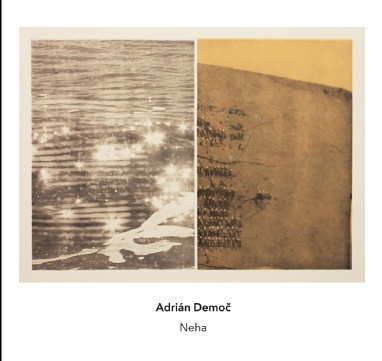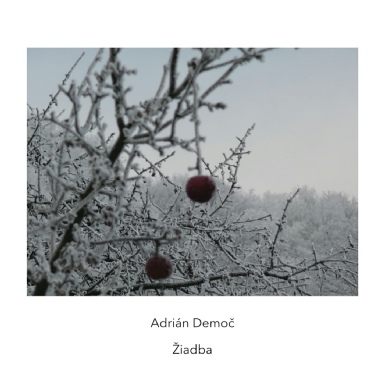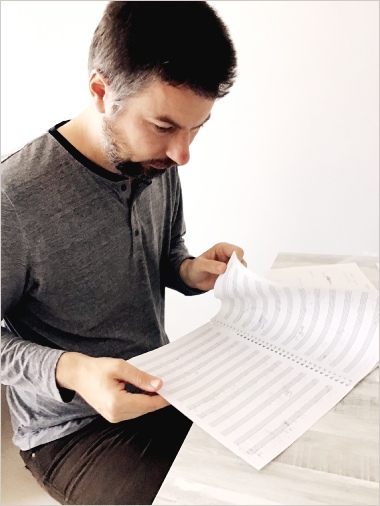Another Timbre TimHarrisonbre

Interview with Adrián Demoč by Marat Ingeldeev
There are three pieces on this CD. The first, Zamat, has an airy quality, with an inquisitive melody played by the clarinets. Given the title’s translation to 'velvet', it seems that texture plays a significant role in the composition. Was exploring texture your primary focus, or were there other elements you wanted to emphasise?
The smooth and slightly dark ‘velvety’ sound does play a significant role in Zamat. And yes, the listener’s main focus could be this: observing the soft delay between individual players, achieved through a technique John Cage referred to as Korean unison (where the instruments’ attacks and individual tempi are close but not perfectly synchronised). Although this technique is thoroughly described in the score, there is no connection to Cage’s aesthetics here and other terms, such as ‘phasing’ or simply ‘delay’, could be used as well. I also personally enjoy the specific timbre of the clarinet and bass clarinet combination. Zamat should be performed with soft dynamics and non vibrato, which is often the case with my music. There are two subtle but clearly audible dynamic layers: a soft yet clear piano and an even softer echo. I find Apartment House’s performance beautiful (and the same goes for the rest of the pieces!). They managed to preserve all these nuances and made it sound very natural.
The second piece, Gebrechlichkeit, translates as ‘frailty’ or ‘weakness’. It immerses the listener in a tense and dark soundworld, with the players’ breathing intensifying the experience and the soundwaves seeming to rub against each other. Could you talk us through how the work unfolds and how you approached building this atmosphere?
You’re right that the German word Gebrechlichkeit means ‘frailty’. I hadn’t considered its secondary meaning, ‘weakness’. I simply liked the sound of the word, which, to my ears, has a certain crispiness or natural tension that resonates well with the music. It’s similar to the Slovak word krehkosť or the Czech křehkost, but I preferred the German term because its length emphasises this whispery quality even more.
As usual, my compositional method was quite straightforward: I listened to the music repeatedly, immersing myself in it with attention. I did not adhere to any pre-compositional process or form beforehand but instead followed the music as it developed. This approach often meant removing unnecessary elements, material and repetitions, and avoiding ‘mechanical processes’, rather than adding new components after each internal exploration of the music. I lived with these relatively simple musical elements for several months: one chromatic cluster (and its transposition) of varying durations, a few consonant chords and even fewer unisons or dyads, which are gradually introduced throughout the piece. These elements emerged more from intuition than from deliberate planning. Additionally, Gebrechlichkeit brought up some compositional challenges I hadn’t addressed for years, such as incorporating a strong dynamic contrast at one moment in the piece. The work remains somewhat enigmatic to me.
The strong dynamic contrast you’re referring to indeed came as a surprise to me. In your previous interview with Another Timbre, you describe your preference for writing 'gentle and soft, non-violent music'. What compositional challenges do you face with louder, more violent sonorities?
Generally, I tend to prefer soft and non-violent music. But again, this description is quite broad and fortunately doesn’t impose fixed rules on how I should compose a piece. The same applies to musical situations that are more violent or louder. I simply listen to what the music requires and do my best to respond accordingly.
Going back to Gebrechlichkeit, the entire composition should be played with soft dynamics and non vibrato, although the very basic material, the cluster, does already carry a certain energy or disquiet that may or may not be resolved musically (and contributed to the shape of the work). In this musical context, which feels more like whispering than speaking, there is a tendency in the piece to build towards greater tension (though subtle and not in a mechanical way, as described earlier). The decision to release this tension with a single strong sound (loud, but not espressivo) near the end was quite spontaneous, though it took me several weeks to allow it to remain there. I also felt a musical need to keep everything surrounding it in soft dynamics, avoiding crescendos or decrescendos.
I really like that Gebrechlichkeit exists in three versions: ‘(1) specific instrumentation, (2) open instrumentation with a similar timbre and register, and (3) a "monochromatic polyphonic" instrument, preferably the piano’ as you explain in an interview with Yuko Zama from elsewhere music. Does it mean you were less concerned with the nuances of individual instruments and more focused on how the frequencies interact?
It was a commission for the Prague Quiet Music Collective, which is a quartet consisting of clarinet, violin, double bass and a versatile player, Ian Mikyska, who played electric guitar in this piece. I initially began writing for four instruments ad libitum, but as the work progressed, I realised it could also work well with a more homogeneous sound, such as a string quartet or a solo instrument. Naturally, different versions of the piece highlight various characteristics, such as the ensemble’s breathing and attack times, the blending of the instruments, and their overtones. Each version reveals unique aspects and brings its own discoveries, making them valuable in their own way. While it's not something I always do, several of my pieces exist in various instrumental combinations, somewhat akin to the tradition seen in some of Bach’s or Pärt’s works.
The final work on the CD, …o protón jasu…, also features the whispery quality you mentioned in relation to Gebrechlichkeit and seems to primarily focus on higher frequencies. Could you tell us more about the piece? I'll leave the title's translation to you, as my understanding of Slovak falls short here.
The title comes from a verse by Slovak poet Rudolf Jurolek: ‘Sometimes we miss paradise only by an eyelash of reality, a missing proton of light’. I hold Jurolek's poetry and artistic path in high regard, so the composition is dedicated to him. His verse captures a sensation that I felt while composing, or 'searching for', this music. It’s quite elusive and personal, but to simplify, it’s a feeling of longing or almost arriving somewhere.
The title also metaphorically refers to the tiny microtonal deviations used throughout the piece. Unlike Gebrechlichkeit, …o protón jasu… was written for a very specific instrumentation, similar to Zamat. It is (again like Zamat) based on a single monodic line, although there are several exceptions. In Zamat, the melody is played by the clarinets, with the strings adding gentle pizzicatos (except at the very end). In contrast, …o protón jasu… highlights the sound of bowed strings, while the clarinets form a kind of ‘shadow’ with attacks, dynamic accents, hocketing and occasional unison doubling. But again, there are exceptions.
at229 Adrián Demoč ‘Zamat’
Three chamber works played by Apartment House.
You can hear brief extracts from each of the pieces on the Youtube link below.
1 ‘Zamat’ (2023)
Raymond Brien, clarinet Heather Roche, bass clarinet Chihiro Ono, viola Anton Lukoszevieze, cello
2 ‘Gebrechlichkeit’
Mira Benjamin & Gordon MacKay, violins Bridget Carey, viola Anton Lukoszevieze, cello
3 “...o protón jasu....”
Heather Roche & Raymond Brien, clarinets Chihiro Ono, viola Anton Lukoszevieze, cello
Adrián Demoč
Other albums by Adrián Demoč
Click on covers for more details
These albums are available at reduced prices until the end of October 2024




